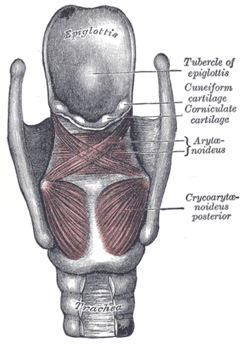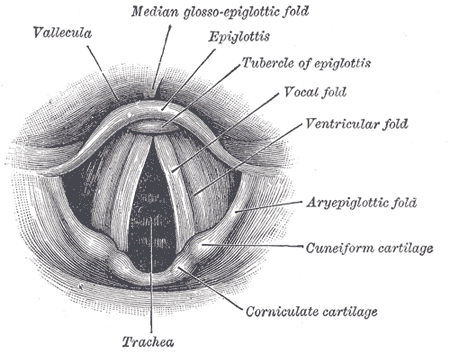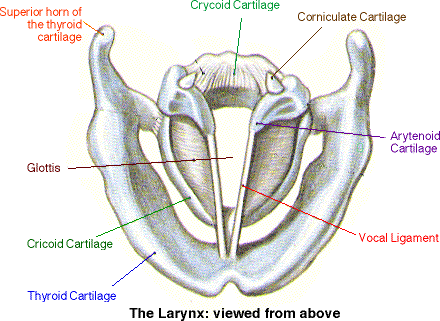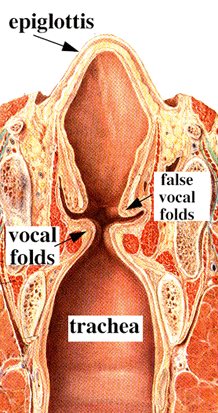"Glottal Opera"
« previous post | next post »
The flexible fiber-optic laryngoscope was invented by a group including Osamu Fujimura, my former boss at Bell Labs (Masayuki Sawashima, Hajime Hirose, and Osamu Fujimura, "Observation of the Larynx by a Fiberscope Inserted through the Nose", JASA 1967). During the past 45 years, this technology has become a routine part of otolaryngology. This 2009 film by John Fink used an Olympus ENF-V2 Video Rhinolaryngoscope:
Each view shows the larynx from the top, with the front of the head and neck facing the bottom of the screen. The relatively bright arc towards the bottom of the view is the epiglottis, which attaches to the rear of the tongue and folds down to protect the airway when swallowing:

The V-shaped opening that appears when the singers breathe, and then closes into a pair of elongated vertical structures when they vocalize, is the glottis itself, with those vertical structures being the "vocal cords" or "vocal folds" or "vocal ligaments":

The structures pulling the rear of the glottis apart and together are the arytenoid cartilages:

The larynx is quite a complicated little machine. Here's a diagram that's useful in explaining some of the muscular forces involved in positioning the vocal cords for vocalization and in adjusting pitch and voice quality:
(The rod apparently stuck through the thyroid and cricoid cartilages is an unfortunate attempt to represent the crico-thyroid joint as an axle…)
This coronal section through the larynx and allied structures may be helpful:

For further information about the anatomy and physiology of the larynx, see the Wikipedia entries for "larynx", "muscles of the larynx" and "vestibule of larynx", the "Animation of Vocal Fold Vibration" from the Wikipedia article on modal voice, etc.

Dan Lufkin said,
August 7, 2012 @ 10:01 am
When opera brings a catch to my throat, it's usually Puccini. Thanks for broadening my scope.
Thom said,
August 7, 2012 @ 10:17 am
The diagrams now seem upside-down when comparing it to the video. It is quite amazing to see this organ at work.
Hamish said,
August 8, 2012 @ 5:33 pm
See also: this footage of the vocal cords of Mel Blanc, voice of Bugs Bunny, Yosemite Sam, Daffy Duck, and other such looney toons:
http://www.youtube.com/watch?v=ejVQEFbIfmI